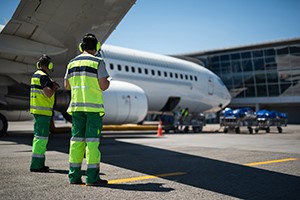How to Prevent Runway Incursions and Keep Airport Ground Crews Safe

Airports are getting busier and busier, which makes runway traffic more complicated and dangerous for the teams that keep it all going. Not only are they responsible for ensuring a plane’s safety and readiness for flight, but their daily tasks expose them to significant and unique hazards. These include runway incursions, dangerous incidents when a person or vehicle enters the wrong section of the landing area, taxiway, or apron. Preventing these, and protecting the lives of staff and passengers, depends on standardized communication, safety procedures, and proper equipment.
Ground Crew Best Practices
Regardless of airport layout or traffic patterns, some procedures can keep ground crew safe in any situation.
· Know and utilize all standard signs and markings used at airports, as well as standard phraseology when communicating with air traffic control (ATC)
· Be familiar with the layout and traffic patterns of your airport, especially movement areas (runways and taxiways)
· Exercise caution and wait for clearance when crossing the Runway Safety Area (RSA), used by aircraft in emergency situations
· Be aware of any nonstandard traffic patterns and rules of your airport
· Maintain caution when working on aprons or ramps where aircraft park
· Watch for an aircraft’s red rotating beacon, which turns on when the engine is about to start or is running
· Maintain a safe distance around parked aircraft; “jet blast” from an aircraft engine starting creates a force that can cause injury and even vehicle overturns
Runway Driving Best Practices
Driving and towing aircraft through high-traffic and complicated movement areas creates significant risk of collision. ATC clearance is one aspect of safe operations, but much of the responsibility rests with the ground crew.
· Follow airport diagrams, and observe extra caution around marked hot spots, locations with a history or potential of collision risk
· Yield right-of-way to moving aircraft, and be aware that cockpits have a limited field of vision and pilots may not see you
· Ensure you have approval to drive or work in areas adjacent to runways, where aircraft wings and engines may extend overhead
· Utilize standard communications procedures and terminology when contacting ATC, and write down their taxi instructions
· Never cross a holding position marking without ATC instructions, which are given to vehicles one at a time
· Uncertain where you are in the movement area? STOP and contact ATC for assistance
Keeping Your Ground Crew Safe
An informed and attentive crew is vital, but industry standard communications systems and safety procedures should be in place. The Federal Aviation Administration (FAA) recommends these additional safety measures.
· A safety management system (SMS), a set of policies and procedures implemented by airlines and large commercial airports to identify and address potential hazards
· Revised and upgraded signaling technology, such as Runway Status Lights (RSL)
· Functional radios tuned to the proper frequency
· Wheel chocks used whenever a towing operation has been temporarily stopped or fully parked
· Hi-visibility clothing for all ground crew employees
· The proper tow-bar for the type of aircraft being moved



